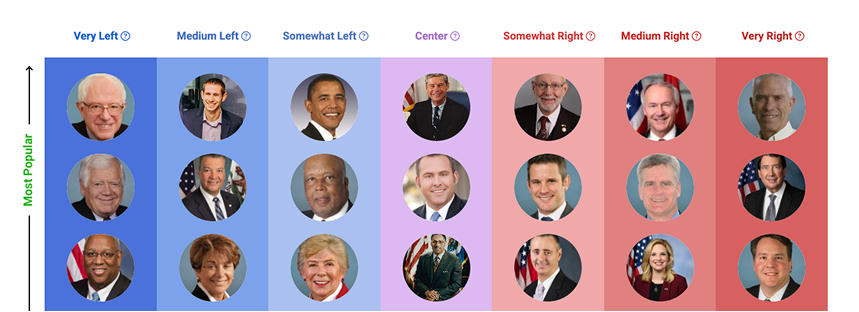Politicians' Bias Ratings
Politicians are unique. Each have differing preferences and aptitudes towards political topics and policies engulched in our current political system. Our politician ratings use sentiment data, entity recognition and other tools to show each politicians’ stance on a certain policy.

Politician Bias Rating List
Our detailed politician bias ratings list tracks politician leanings across the political spectrum, from progressive to conservative ideologies including how the media portrays politicians.
Our detailed politician bias ratings list tracks politician leanings across the political spectrum, from progressive to conservative ideologies including how the media portrays politicians.
About the Politician Bias Ratings
Biasly’s Politician Bias Ratings provide a transparent, research-backed way to assess the political leanings of elected officials and public figures across the ideological spectrum. As a trusted platform for evaluating political bias ratings, our mission is to help voters, journalists, and researchers understand where politicians stand—based on their statements, policy support, voting history, and media portrayal.
By analyzing types of political bias—such as partisan rhetoric, issue framing, and consistency across platforms—our system offers insight into how politicians align with liberal or conservative political leanings, and how those leanings are represented across the media. Whether you’re exploring bias in politics, comparing public figures, or trying to spot trends in politician leanings and portrayals, our ratings help you make informed, unbiased decisions in an increasingly polarized political landscape.

Politician Bias Chart
Biasly’s Politician Bias Chart is a powerful visual tool designed to help users evaluate the political leanings and bias ratings of U.S. politicians. Whether you’re researching liberal political leaning, identifying conservative bias, or exploring the types of political bias found in public statements, our chart offers a clear, evidence-based way to compare elected officials across party lines.

Our interactive chart maps politicians based on two key metrics:
- Ideological Leaning: Liberal, Moderate, Conservative
- Media Portrayal Bias: How they’re represented in both left- and right-leaning news sources
Using our proprietary Political Bias Meter, each politician is scored according to their voting record, public statements, supported policies, and how their views are reflected in both left- and right-leaning media coverage. From progressive Democrats to far-right Republicans, our political bias ratings help you see where public figures truly stand on the ideological spectrum.
Powered by AI + Human Insight
The chart is updated regularly and draws from a combination of advanced machine learning models and analyst reviews, ensuring Biasly remains one of the most comprehensive and transparent platforms for understanding politician bias ratings. Curious about where your representatives rank? Explore the chart and gain insights into the political leanings of politicians, their portrayals in news media, and how their positions evolve over time.
How We Rate Political Bias
Biasly’s politician bias ratings are powered by a hybrid model that combines AI-driven analysis with expert political research. This allows us to deliver the most transparent, consistent, and insightful political bias ratings across the political landscape. Here’s how we measure the political leanings of politicians with accuracy and depth:

Analyst + A.I. Collaboration:
Our trained analysts work closely with machine learning models to evaluate patterns in language, voting records, policy endorsements, and public statements. This dual approach ensures that each politician’s political leanings and portrayals are assessed through both human interpretation and algorithmic objectivity.
Public Statements vs. Policy Support:
To ensure a balanced analysis, we separately evaluate a politician’s direct rhetoric (e.g., interviews, speeches, tweets) and their policy actions (e.g., bills sponsored, votes cast). This distinction provides a deeper understanding of bias in politics and avoids overgeneralizing based on soundbites.
Dynamic Rating System:
Our politician bias meter updates in real time, factoring in shifts in tone, new voting behavior, and media coverage patterns. These changes are reflected in our politician bias chart, helping you track trends and identify political bias examples over time.
Representative Dataset:
We include politicians at the federal, state, and local levels—across the ideological spectrum—to create a well-rounded political rating system. Whether you’re researching liberal political figures, conservative representatives, or centrists, our data ensures wide and fair representation.
Why Political Bias Ratings Matter
Understanding a politician’s bias rating helps you see the broader political leanings behind their decisions, rhetoric, and policies. Our goal is to promote transparency—not polarization—by helping users think critically about political narratives and affiliations.
Patterns Over Moments
Our political ratings reflect long-term patterns in voting behavior, public statements, and media portrayals—not isolated quotes or single events.
Bias Can Change
Politicians evolve, and so do their political leanings. Our system updates regularly to capture new data, policy shifts, and changes in media coverage.
“Center” ≠ neutral
A center rating doesn’t mean a politician is without bias—it often reflects a blend of liberal and conservative views. Cross-referencing multiple sources helps paint a clearer picture.
Empowering Voters
By understanding the types of political bias, users can better interpret campaign messaging, question assumptions, and make more informed electoral choices.
What the Ratings Mean
Biasly’s ratings use a 7-point Political Bias Scale to categorize outlets, ranging from Extreme Left to Extreme Right. Each category reflects the outlet’s overall bias pattern, not individual articles. Here’s how it works:
| Very Left -71% to -100% | Advocates for radical systemic change (e.g., “Dismantle economic oppression now”). |
|---|---|
| Medium Left -41% to -70% | Mainstream left-leaning, supports progressive policies incrementally (e.g., “Raise taxes on the wealthy to fund social programs”). |
| Somewhat Left -10% to -40% | Leans left but occasionally holds moderate/right views (e.g., “Support abortion rights with some restrictions”). |
| Center -10% to -10% | Strives for neutrality but may still miss perspectives. |
| Somewhat Right 10% to 40% | Leans right with occasional moderate views (e.g., “Secure borders compassionately”). |
| Medium Right 41% to -70% | Mainstream conservative, incremental change (e.g., “Limit abortion with exceptions”). |
| Very Right 71% to 100% | Far-right ideology, uncompromising language (e.g., “Mass deportation of undocumented immigrants”). |
Example: On abortion, a Very Left outlet might state, “Abortion access is non-negotiable,” while a Very Right outlet might call it “a sin against God.”
Continue For Free
Create your free account to see the in-depth bias analytics and more.
Continue
Continue
By creating an account, you agree to our Terms and Privacy Policy, and subscribe to email updates. Already a member: Log in




















